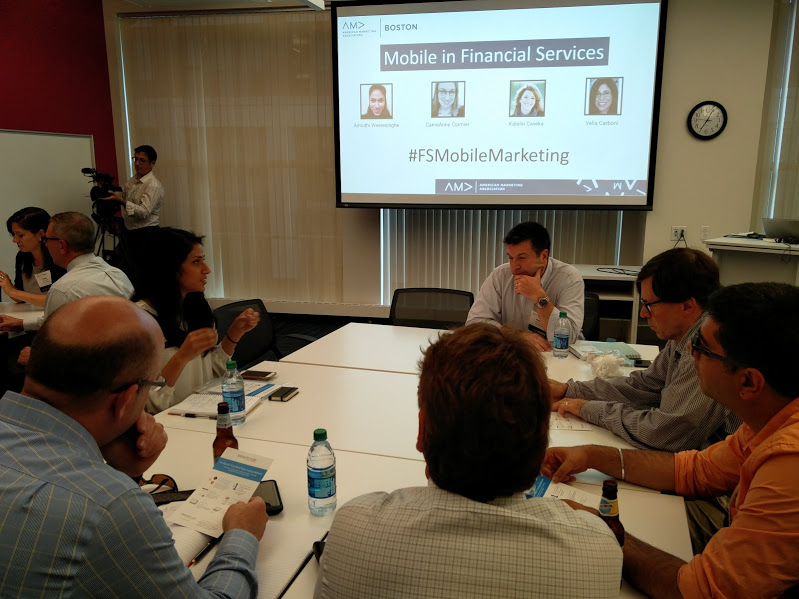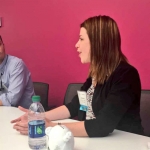Financial services marketing experts and an audience of AMA Boston members and guests hungry for insights on mobile technology and media combined for a terrific evening on June 21st at the Non-Profit Center in Boston. After networking opportunities to start the evening, the unique round table (also dubbed “loud table” as the energy rose in the room) format commenced, offering the attendees a chance to dive deeply into how mobile is transforming the financial services industry.
 The audience was very fortunate to have a very experienced group, in an event organized by AMA Boston board member Patrick Cote. Four speakers from Fidelity, Avidia and UStocktrade educated and energized their respective tables – see their full bios here and read on for a recap, including a cool SnapChat video! The format featured the speakers spending 15 minutes at one table before moving to the next.
The audience was very fortunate to have a very experienced group, in an event organized by AMA Boston board member Patrick Cote. Four speakers from Fidelity, Avidia and UStocktrade educated and energized their respective tables – see their full bios here and read on for a recap, including a cool SnapChat video! The format featured the speakers spending 15 minutes at one table before moving to the next.
Speakers and Key Points
Fidelity Investments
Velia Carboni
SVP, Mobile
Fidelity’s mobile activity started in 1999 but took time to get going. Velia noted that “our early clients were multi-platform users and mobile centric, so we adapted our business early for this.” New clients are more focused on mobile, as Velia mentioned that “users are doing financial and investor research on mobile,” so Fidelity has had to adapt their business to reflect this new focus by their target audience.
- Apps need to be simple and drive day-to-day engagement – do not try and include everything; send people to the website for details. First test in the market, then add features after getting feedback. Less is more on mobile app; minimal clutter, easy to use, personalized. The design of the app was based on the needs of millenials, specifically the swiping technology. Apps are ideal for day-to-day activities, while the website is best for less regular activities, e.g. opening an account.
- Platform management: be on all platforms – desk top, mobile, watch, TV
- Social: Fidelity took learnings from LinkedIn and Facebook to provide users with a personalized feed of relevant content based on their browsing and other activity.
- What’s coming: beyond the current phase 1, more developments coming, including.using location more effectively to see what stocks to buy where, providing different information based on users’ profile and interests, and building more “if, then” capabilities.
- Focus: On the customer and the technology.
Avidia Bank
Carrie Anne Cormier
AVP, Retail Operations & Strategy
Carrie Anne described Avidia’s “focus as being on convenience through mobile technology, e.g. our Cardless Cash feature on our app.” She also provided the interesting and somewhat surprising observation that “our average user age of CardlessCash is 41 so it’s not just millennials who are using mobile tech!”
- Mobile strategy: it’s being used to generate new customers and service existing customers while helping differentiate Avidia from competitors. They aspire to attract a younger audience but persuade older users to engage on mobile too. Another aim is to try and bring some fun into the industry! They are also educating more employers to be capable of selling mobile products. The summer marketing campaign is mobile focused, they are moving towards a mobile wallet, and texting gift cards are being developed.
- Social media: discovered it’s critical, as they have a broad target audience and need many touch points to reach them. Used more social media mix – live tweets, Periscope etc. Was unusual as not usually do this. Showing the technology live before going to market helped generate discussion – Facebook, Snapchat and more, all while testing the market.
- The CardlessCash product launch: there were 9 million impressions from the product launch last August It has helped Avidia to attract new partners and increased the number of new accounts and younger customers.
- Channels are becoming even more important. Avidia is focusing on an omni-channel strategy; the bank can can cross sell, offer benefits, and convenience of doing transactions online; mobile has led to a 40,000 reduction in transactions; and the bank can now cross sell to the 7,000 users of the mobile app.
Avidia Bank
Katelin Cwieka
Marketing Specialist
Kate advised her table mates that “people want to join a company that resonates with them. Humanize your brand.” She also confirmed the importance of social media as a connection point: “Avidia uses social media to engage with our communities.”
- Video can be a powerful tool to share content but is currently regulated.
- Marketing and promotional tactics included a scavenger hunt with a mascot to drive engagement and digital promotion with live streams that drive downloads of the app. The bank provided demos in branches where people could ask questions, a mailer with step-by-step instructions, and ATM interactive centers in branches. In addition, Avidia supported their app with traditional advertising.
- Personal connection: make people feel like an insider, including using influencers to help.
uStockTrade
Amodhi Weeresinghe
Social Media & Business Development
Amodhi was excited to announce that “more than half of Ustocktrade’s traffic is from mobile,” an impressive statistic. With Ustocktrade breaking into the industry with a new service, they use a simulator so people can test it out and then decide. Her insights on their mobile strategy included “to reach our millennial audience, we developed a mobile app and engaged with them on Instagram and Twitter.”
- First alternative trading system includes the direct placement of an order executed on the same platform, easy and affordable usage, same-day settlement, and service availability on the Apple store and all web browsers.
- Mission: get millennial audience to invest. They want to bring Wall Street to main street = so even if investors can’t trade, they can still engage.
- Targeting strategy: Most millennials are college students and young professionals, so Ustocktrade needed to be more accessible, leading to mobile. They went to where millennials connect, such as chat rooms and social media handles, as well as deploying Google to help identify the audience before leveraging online social networks. Marketing to millennials is a challenge as they expect an immediate reply and want to feel valued.
- Influencers: The company looks for key influencers and engages them on product. Hand-written notes from the CEO with a T-shirt and requests for the customer to post a picture on social media resulted in 500% growth in a recent four-week period. The goal is to keep users involved, as 53% of traffic to website comes from mobile.
Closest Thing to Being There – See the SnapChat Video!
AMA Boston thanks the top-notch speakers and audience for a great evening. We hope to see you at our big summer networking event on July 28th, sure to be serious fun and a great chance to meet more like-minded marketers!






